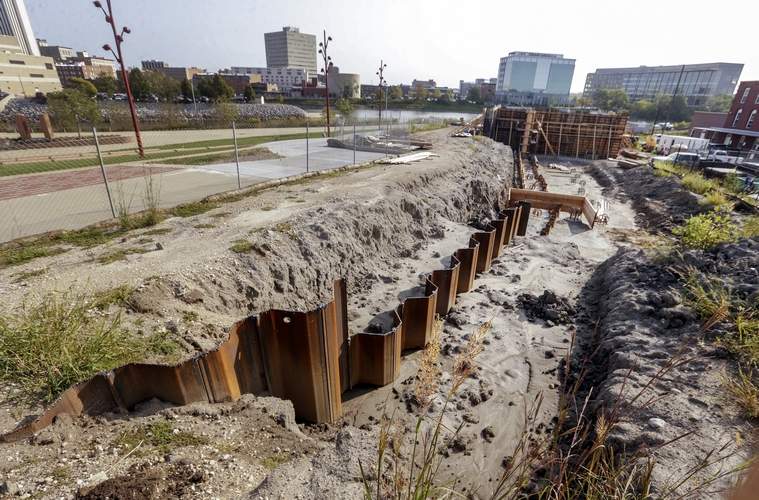Study: Cedar Rapids’ investment in flood protection fuels local economy

Permanent infrastructure shows developers city has ‘a plan in place’
CEDAR RAPIDS — Flood threats are too familiar to Al Pierson, owner of a 92-year-old business in the Time Check neighborhood.
He recalls six times that Pierson’s Flower Shop and Greenhouses, 1800 Ellis Blvd. NW, has faced rising waters from the Cedar River. He’s had to evacuate before, but the 2008 flood marked the first time floodwater actually came on the property.
“It isn’t just the people that get wet,” said Pierson, whose business closed for five months after the flood. “It’s the whole city that is affected — mentally, physically, economically.”
When businesses get flooded, they have to close for prolonged periods or potentially relocate, Pierson said, ultimately hurting the economy and the workers who fuel it.
The city estimates a local economic loss of $25 million when businesses have to shut down for flood fights, according to its website. That’s what officials aimed to protect against when the City Council in 2015 approved plans to build over years a flood control system to protect properties near the Cedar River. The city estimated it would cost $750 million over 20 years.
Pierson said he is eagerly waiting for the permanent protection to extend to his business while construction is expected to continue into the 2030s. He understands it takes time, but said he “can’t wait for it to be finished.”
“I think that they’ve got a great plan. They’re executing it,” Pierson said. “My only complaint would be I want it now.”
Such investment in flood protection infrastructure stimulates economies, driving business creation and job growth, according to a new study by Johns Hopkins University’s 21st Century Cities Initiative and the American Flood Coalition.
In this report, released in December, Cedar Rapids serves as a case study of a city that leveraged investment from local, state and federal government agencies to fortify its infrastructure against floodwaters and boost the local economy.
“ … The severe river flooding in 2008 devastated local homes and businesses, but rather than impede redevelopment efforts, the City Council doubled down on investing in flood resilience,” Melissa Roberts, executive director of the nonpartisan American Flood Coalition, said in a statement. “This investment led to a revitalization of the downtown and riverfront, as well as an increase of local jobs and property values.”
In the Cedar Rapids Combined Statistical Area, researchers found that businesses classified as being in the wholesale industry, which provided the raw materials for infrastructure construction, saw employment grow 13.6 percent over the construction period studied, while there was a statewide drop of 0.78 percent. Within the durable goods sector of the wholesale industry, employment increased 21 percent compared with 13 percent statewide.
Flood Control Program Manager Rob Davis said the city expects to lead that growth in construction jobs through the foreseeable future with flood control. So far, the city reported a total investment in the roughly 7-mile system of about $126 million by the end of fiscal 2020, the budget year that ended June 30, since design work started on the system in 2014.
The permanent system incorporates amenities and green space into the infrastructure, particularly with projects like the flood wall extension and restroom storage building at McGrath Amphitheatre, blending the environment with flood-resilient infrastructure.
“I think the wrong thing to do would be to fear the river and to wall off from the river,” Davis said.
City Economic Development Analyst Caleb Mason said this has the added benefit of attracting people to an area and encouraging development.
The investment in protective infrastructure demonstrates to developers that there is “a plan in place, and it’s being executed on that we’re at least de-risking some of that potential that may otherwise cause people to move elsewhere,” Mason said.
That demonstration is key to spurring key redevelopment projects, he added. He mentioned as an example the city’s recognition with a Phoenix Award in 2017 for redevelopment initiatives that pumped new life into the local economy: The NewBo Market; the Geonetric Building that houses Geonetric Inc., the Iowa Startup Accelerator, Vault coworking lab and Iowa BIG; and The Depot.
“Those projects wouldn’t happen if we couldn’t demonstrate that we could protect those areas, or had a plan to do so,” Mason said.
The city’s $44 million investment after the flood in the New Bohemia and Czech Village districts, adjacent to the Cedar River, has helped arts and entertainment flourish in the area. According to the study, the city saw its property valuation there rise from $29 million to $46 million between 2008 and 2016.
Overall since 2008, the city reports $359.5 million in economic development projects in the flood area that have been completed or approved.
As the city’s work ramps up in all parts of the flood control system, spanning from Shaver Road NE and near the Otis Road SE Cargill corn milling facility, Davis said confidence in redevelopment appears to be accelerating “because we’re actually following through on that and you’re seeing construction out there.”
Comments: (319) 398-8494; marissa.payne@thegazette.com
CREDIT: . (2021, January 11). Study: Cedar Rapids’ investment in flood protection fuels local economy. The Gazette. Retrieved from https://www.thegazette.com/

